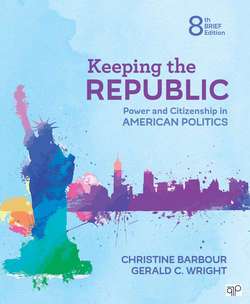Читать книгу Keeping the Republic - Christine Barbour - Страница 11
На сайте Литреса книга снята с продажи.
Preface
ОглавлениеTHIS eighth brief edition of Keeping the Republic is designed for those who want a concise, streamlined, inexpensive, and engaging version of its longer, more comprehensive parent. Brief books do not have to be dull! While we have condensed the longer text’s account of the American political system, we have taken great pains to preserve the accessibility and enthusiasm of that book. Our goal was to meet the needs of those looking for a shorter text to use with various supplemental readings, as well as those who want broad coverage in a price-sensitive package.
We have also stayed true to our original goal in writing the text: to share the excitement of discovering humankind’s capacity to find innovative solutions to those problems that arise from our efforts to live together on a planet too small, with resources too scarce, and with saintliness in too short a supply. In this book we honor the human capacity to manage our collective lives with peace and even, at times, dignity. And, in particular, we celebrate the American political system and the founders’ extraordinary contribution to the possibilities of human governance.
This book covers essential topics with clear explanations, but it is also a thematic book, intended to guide students through a wealth of material and to help them make sense of the content both academically and personally. To that end we develop two themes that run throughout every chapter: an analytic theme to assist students in organizing the details and connecting them to the larger ideas and concepts of American politics, and an evaluative theme to help them find personal meaning in the American political system and develop standards for making judgments about how well the system works. Taken together, these themes provide students a framework on which to hang the myriad complexities of American politics.
The analytic theme we chose is a classic in political science: politics is a struggle over limited power and resources, as gripping as a sporting event in its final minutes, but much more vital. The rules guiding that struggle influence who will win and who will lose, so that often the struggles with the most at stake are over the rule making itself. In short, and in the words of a famous political scientist, politics is about who gets what, and how they get it. To illustrate this theme, we begin and end every chapter with a feature called What’s at Stake . . . ? that poses a question about what people want from politics—what they are struggling to get and how the rules affect who gets it.
Our citizenship theme has three dimensions. First, in our Profiles in Citizenship feature, present in every chapter, we introduce students to important figures in American politics and ask the subjects why they are involved in public service or some aspect of political life. Based on personal interviews with these people, the profiles model republic-keeping behavior for students, helping them to see what is expected of them as members of a democratic polity. We feel unabashedly that a primary goal of teaching introductory politics is not only to create good scholars but also to create good citizens. Second, at the end of nearly every chapter, the feature The Citizens and . . . provides a critical view of what citizens can or cannot do in American politics, evaluating how democratic various aspects of the American system actually are and what possibilities exist for change. Third, the Don’t Be Fooled by . . . feature assists students to critically examine the various kinds of political information they are bombarded with—from information in textbooks like this one, to information from social networks, to information from their congressional representative or political party.
The book’s themes are further illustrated through two unique features that will enhance students’ visual literacy and critical thinking skills. Each chapter includes a rich, poster- worthy display called The Big Picture that focuses on a key element in the book, complementing the text with a rich visual that grabs students’ attention and engages them in understanding big processes like how cases get to the Supreme Court, big concepts such as when the law can treat people differently, and big data, including who has immigrated to the United States and how they have assimilated. In addition, an innovative feature called Snapshot of America, reimagined from the Who Are We feature of past editions, describes through graphs, charts, and maps just who we Americans are and where we come from, what we believe, how educated we are, and how much money we make. This recurring feature aims at exploding stereotypes, and Behind the Numbers questions lead students to think critically about the political consequences of America’s demographic profile. These visual features are the result of a partnership with award-winning designer, educator, and artist Mike Wirth, who has lent his expert hand in information design and data visualization to craft these unique, informative, and memorable graphics.
We have long believed that teaching is a two-way street, and we welcome comments, criticisms, or just a pleasant chat about politics or pedagogy. You can email us directly at barbour@indiana.edu and wright1@indiana.edu.
